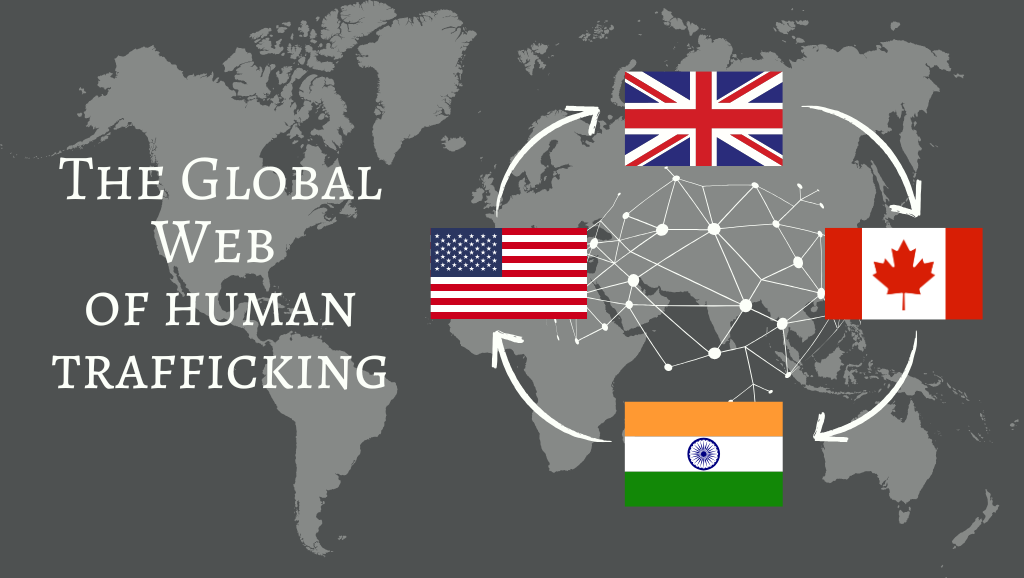Human trafficking is not confined by borders. While we often think of trafficking as a local issue, the reality is far more complex. In today’s globalized economy, countries like the United States, United Kingdom, and Canada are directly and indirectly linked to trafficking operations happening in places like India. From the products we buy, to the workers in our supply chains, to the students and migrants arriving at our borders—human trafficking is both an imported and exported crisis.
So what happens when we turn a blind eye? The cost—economic, political, and social—is staggering.

How the USA, UK, and Canada Are Connected to Human Trafficking in India
India, with its vast population and socio-economic disparities, is both a source and a destination for human trafficking. Victims, primarily women and children, are trafficked for forced labor, sexual exploitation, domestic servitude, and even organ harvesting. But the chain doesn’t stop at India’s borders.
1. . Labor Trafficking in Global Supply Chains
Many goods imported into the USA, UK, and Canada—especially garments, textiles, jewelry, and tech components—are produced in conditions that violate human rights. A 2020 U.S. Department of Labor report listed Indian industries like handwoven textiles, stone quarrying, and embroidered garments as high-risk sectors for child labor and forced labor.
Multinational corporations headquartered in the West often rely on suppliers or subcontractors in India where monitoring is lax. These goods enter Western markets, effectively making consumers unwitting participants in the trafficking economy.
Example:
In 2014, a major British fast fashion retailer was found sourcing clothes from Indian factories using underpaid and trafficked children. While the brand denied knowledge, the damage to its reputation was swift and severe.
2. Student and Work Visa Loopholes
Human traffickers exploit immigration systems. Trafficking victims from India are often brought into the US, UK, and Canada under the guise of work, study, or marriage. Once they arrive, they may find themselves trapped in domestic servitude or coerced into sex work, unable to escape due to threats, language barriers, or fear of deportation.
Example:
In Canada, the 2022 “Fake Colleges” scam involved hundreds of Indian students deceived into enrolling in bogus institutions. Many paid large sums to agents and ended up in exploitative labor conditions, some even facing deportation after speaking out.
3. Tech-Fueled Sex Trafficking
The UK and North America have seen a disturbing rise in online child sexual abuse material (CSAM), much of which is produced in South Asia, including India. Victims are often coerced by traffickers into creating explicit content for Western consumers. Demand drives supply.
Example:
A 2019 Europol operation exposed a network distributing child abuse content produced in Indian slums to paying clients in the UK and the US. These clients were not just passive consumers—they funded the abuse.
The Cost of Doing Nothing
• Economic Cost
Human trafficking costs the global economy an estimated $150 billion annually, according to the International Labour Organization. Countries like the US, UK, and Canada bear the burden in multiple ways:
- Increased healthcare costs for survivors
- Strain on social services and law enforcement
- Reputational damage to companies complicit through supply chains
- Loss of tax revenue as illicit labor thrives underground
• Political Cost
When governments fail to act, they erode public trust. Immigration becomes politicized, trade deals are scrutinized, and diplomatic relations may suffer.
Example:
Canada’s weak response to the 2022 student trafficking scandal strained relations with India and triggered calls for immigration reform. Inaction fueled xenophobic rhetoric and created division instead of solutions.
• Social Cost
Doing nothing sends a message: some lives are expendable. Trafficking destroys families, destabilizes communities, and fuels organized crime. Survivors often suffer lifelong trauma, becoming isolated and underserved.
In all three countries, diaspora communities are impacted as well. Families are extorted, women are silenced, and youth are targeted. Silence is complicity.
What Needs to Change:
1. Stronger International Cooperation
We need better coordination between law enforcement in India and Western countries. Joint investigations, data sharing, and survivor repatriation must be prioritized.
2. Ethical Supply Chain Audits
Companies in the USA, UK, and Canada must conduct third-party audits and adopt transparent sourcing. Modern slavery statements should be mandatory and enforceable.
3. Visa Reform and Survivor Protections
Close visa loopholes, protect whistleblowers, and offer legal pathways for victims to stay and recover rather than face deportation.
4. Investment in Prevention and Aftercare
Fund grassroots anti-trafficking organizations in India and diaspora support programs in the West. Prevention is cheaper—and more humane—than rescue.
Conclusion
Human trafficking is not just “an Indian problem”—it’s a global issue with deep ties to how the West does business, manages immigration, and consumes labor and services. If we ignore it, we pay the price—in dollars, in trust, and in lives. But if we act, together, we can create a world where freedom is not a privilege for the few, but a right for all.
